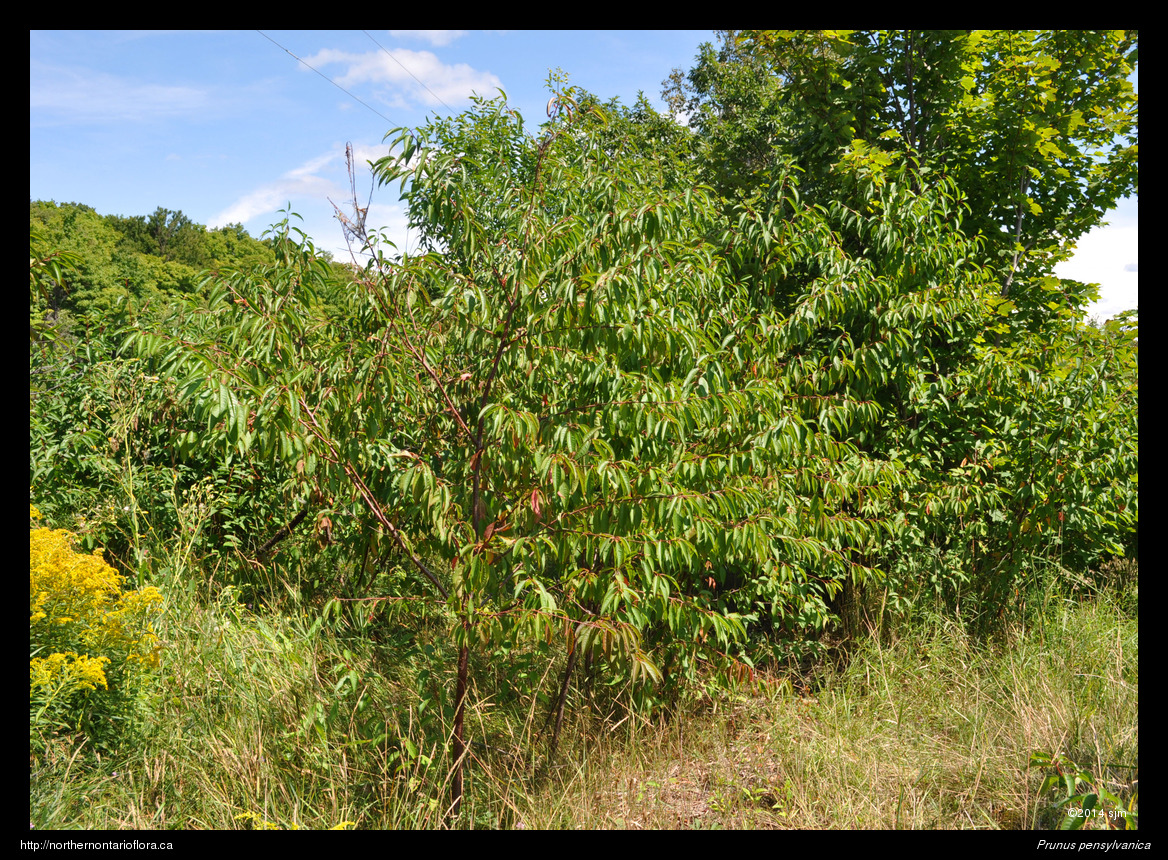
|
Northern Ontario Plant Database 
Plant DescriptionPrunus pensylvanica L.f.En: pin cherry, fire cherry, bird cherry
Rosaceae (Rose Family) General: A tall, deciduous, shrub or tree, to 12 m tall; reproduces vegetatively by root sprouts and often forms thickets. Stems/twigs: The shiny, dark reddish-brown bark is marked by prominent, horizontal, pale lenticels. Twigs are also reddish brown and have a disagreeable bitter almond taste and smell when crushed. Buds are small, ovoid, and blunt, with several overlapping bud scales. Buds are alternately-arranged along the length of the twig, with several buds clustered at the tip of overwintering branches. Leaf scars are small and semicircular, with 3 bundle trace scars. Leaves: Alternate, simple, pinnately-veined, petiolate. The petiole is 1-3 cm long and bears minute glands near the blade. Leaf blades are lanceolate to narrowly elliptic, 8—15 cm long, yellow-green to dark green, smooth (glabrous), and somewhat shiny above; bases rounded; blade gradually tapering to a sharply pointed (acuminate) apex, leaf margins are finely toothed (serrate), with blunt teeth that are gland-tipped when young. Flowers: Bisexual, arranged in umbel-like clusters (corymbs) of 2-6 flowers, each 1.2-1.6 cm across, borne on short shoots; the flower stalks (pedicels) are 1-2 cm long. The calyx forms a cup-shape hypanthium that surrounds the single, superior ovary. Attached to the rim of the hypanthium are 5 reflexed calyx lobes, 5 white, rounded petals, and 25-30 stamens. Flowers bloom as the leaves emerge in late May to early June. Fruit: Each flower develops into a small, bright red, globose cherry (drupe), 4—7 mm in diameter, with very tart but juicy, edible flesh and a single, stony, globose pit (endocarp). Fruits mature in late summer. Habitat and Range: Dry, open woods, old burns, disturbed areas, rights-of-way, and roadsides. Pin cherry is native to north-temperate and boreal North America; its range extends from central Labrador west to central British Columbia. Pin cherry is found throughout all regions of Ontario south of the Hudson Bay Lowlands. Similar Species: Vigorous root shoots may have very large robust leaves that look similar to those of choke cherry (Prunus virginiana L.), but leaves of choke cherry are usually widest above the middle and have flowers and fruit arranged in a long raceme. In wet habitats, leaves of the shining willow (Salix lucida Muhl.), may be mistaken for pin cherry, but the shining willow has leaves with a longer, narrower apex, shorter petioles, 0.5-1.5 cm long, and prominent stipules; pin cherries lack stipules. Back to species list |
||||||||||||||||||||||



























